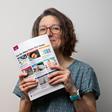Looking forward to an equal gender balance in science
Newspaper and news website headlines around the world last month were full of surprise at the number of women in the Nobel prize-winners line-up: three. Take away the peace prize, look only at the ‘science’ prizes and that number goes down to two. I’ll say that again: there are two women among the prizewinners. Out of ten.

The two women, of course, are Frances Arnold for chemistry and Donna Strickland for physics. It’s only the third time that the physics prize has gone to a woman (Maria Goeppert-Mayer in 1963 and Marie Curie in 1903, who also won the chemistry prize in 1911); there are slightly more for chemistry: five.
Recognise the disparity in these statistics, and the media hype is understandable. It begs the question though: how do we get to a scenario where the hype isn’t necessary? When a Nobel prize winner wouldn’t even consider saying ‘I don’t see myself as a woman in science. I see myself as a scientist’ as Donna Strickland did in an interview with the Guardian.
Recognise the disparity in these statistics, and the media hype is understandable. It begs the question though: how do we get to a scenario where the hype isn’t necessary? When a Nobel prize winner wouldn’t even consider saying ‘I don’t see myself as a woman in science. I see myself as a scientist’ as Donna Strickland did in an interview with The Guardian [bit.ly/2yA5OZh].
Reaching that scenario will take time, but the tide is beginning to turn. Also in the Guardian, Frances Arnold predicted a ‘steady stream’ of women succeeding in chemistry and physics. To secure that stream, work has to start in schools. Thankfully, science teachers are alert to the problem. And so far this year, EiC has published four articles that deal with the topic.
Read how the Royal Society of Chemistry is tackling the problem in its Breaking the barriers report.
Reaching that scenario will take time, but the tide is beginning to turn. Also in the Guardian [bit.ly/2NSgrv2], Frances Arnold predicted a ‘steady stream’ of women succeeding in chemistry and physics. To secure that stream, work has to start in schools. Thankfully, science teachers are alert to the problem. And so far this year, EiC has published four articles that deal with the topic.
Girls are being encouraged to study STEM subjects, but sadly 67% of teachers admitted to subconscious stereotyping of boys and girls around STEM subjects, according to a survey by Accenture earlier this year. Parents are key here too; in the survey, 50% admitted to subconscious stereotyping.
Girls are being encouraged to study STEM subjects, but sadly 67% of teachers admitted to subconscious stereotyping of boys and girls around STEM subjects, according to a survey by Accenture [accntu.re/2HBrW7N] earlier this year. Parents are key here too; in the survey, 50% admitted to subconscious stereotyping.
How do we improve efforts to get girls to engage with science and to stick with it? Encouraging the use of non-gendered language could be a start. My colleagues here on EiC for example would never be referred to as men scientists, and no one on earth would dare to call Neil deGrasse Tyson anything other than a scientist.
Role models are another obvious starting point. David Miller from Northwestern University led a recent study examining how boys and girls draw scientists. This study found that while young girls depict female scientists, as they mature a greater proportion draw them as men. Could it be that Frances Arnold and Donna Strickland start to change that dynamic?
Role models are another obvious starting point. David Miller from Northwestern University led a recent study examining how boys and girls draw scientists [rsc.li/2Rlci4W]. This study found that while young girls depict female scientists, as they mature a greater proportion draw them as men. Could it be that Frances Arnold and Donna Strickland start to change that dynamic?
With both scientists focusing firmly on science, their high-profile wins just might influence the girls sitting in your classrooms right now. And if you think there’s anything else EiC can do to help promote equality in science teaching, let us know.














No comments yet